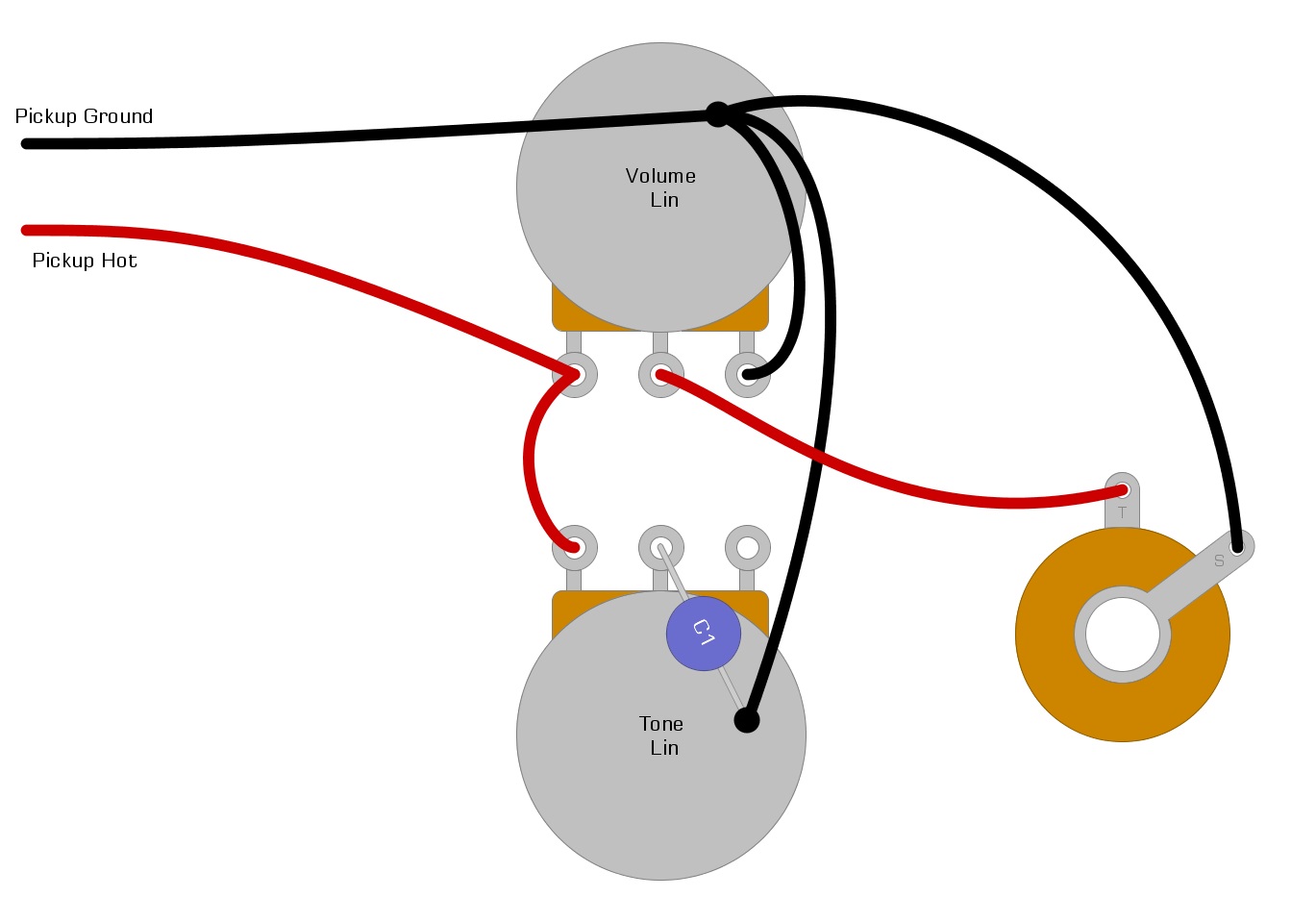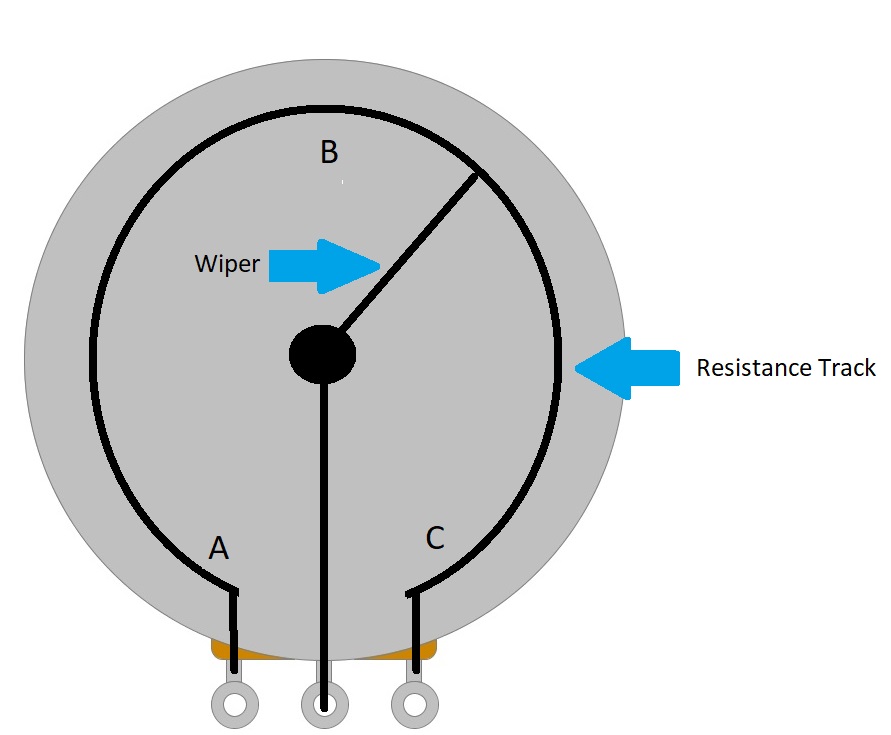
By Ed Malaker
Posted 05/12/2020
One of the most frequent questions that we receive is about selecting the correct value for the volume and tone controls. The standard convention is to use 500k pots when you use humbuckers and 250k pots when your guitar has single-coil pickups, but what would happen if you switched the values, or used one of each?
Let’s take an in-depth look at mixing 250k and 500k ohm potentiometers. We’ll talk about why we use these values and how they affect the guitar circuit and your tone.
The Pickups
It all starts with the pickups. Whether you use single coils or humbuckers, most of your tone comes from the pickups. There are a lot of other factors — like string gauge, wood type, nut and bridge materials, capacitors, and age — that affect your tone. Changing any of those, however, will not affect the sound nearly as much as a good set of pickups.
- If you want to improve your tone, we recommend making sure you set your guitar up correctly, then looking into new pickups that produce the sound you want. The sound of new pickups is unmistakable, and if you have stock pickups in a budget guitar, they can turn it into a new instrument.
- If you already have the tone you want, and you just want to polish it up a little, we recommend looking at the bridge and nut materials, the capacitors, and the potentiometer values. These things will change the sound very little, and in most cases, the only one that will notice the difference is you.
The Values
I’ve found that many people believe that we use 500k for the humbuckers and 250k for the single-coils because humbuckers use two coils, put out more power, and therefore require the 500k pot. Unfortunately, while this might be a great way to remember the correct values to use with each type of pickup, it’s not the reason we use those values.
The Circuit
The important difference between single-coils and humbucker pickups is their sound. Humbucker pickups are subject to phase cancellation because the two coils are close to each other. This phase cancellation causes humbucker pickups to lose their high frequencies and sound much warmer as a result than single coils. Single-coils are known to tend toward shimmery, harsh, or piercing tones. The difference in potentiometer values contributes to this sound difference.
Let’s look at the basic single pickup wiring diagram in Example 1. Humbuckers and single coils use the same layout.
Example 1
You can see in Example 1 that the signal comes from the pickup and goes to the volume. The signal can then go through the volume to the output jack, or it can go through the tone control to the ground.
Let’s see what’s happening inside a potentiometer, by looking at Example 2.
Example 2
In Example 2, you can see the inner workings of a standard potentiometer. The resistance track runs from Lug 1 to Lug 3. The center lug is the wiper, which you move by turning the volume or tone control up or down.
If you have a 500k volume pot:
- The resistance between point A and point C is 500k
- The resistance between point C and point A is 500k
- The resistance between point A and point B is 250k
- The resistance between point C and point B is 250k
- The resistance between point A and the wiper is more than 250k but less than 500k
- The resistance between point C and the wiper is less than 250k
Now, if we look back at Example 1, we can understand the circuit a little better. The signal comes from the pickup and goes to the volume and the tone. It enters the volume at lug one near point A.
- The closer the wiper is to point A, the more signal can escape through the center lug and travel to the output jack. The further the wiper is from point A, the higher the resistance. More resistance will prevent the signal from reaching the center lug, resulting in less volume. The circuit will act the same if you remove the ground from lug 3 by point C, but it would lift the ground and could create noise.
The signal enters the tone at lug 3, near point C.
- The closer the wiper is to point C, the more signal will be allowed to leak through the capacitor to ground, resulting in less high frequencies and a warmer tone. The further the wiper is from point C, the more resistance will prevent the signal from leaking through the capacitor. Less leaking means more highs and a brighter tone.
Circuit Bleed
If you look at Example 2 again, you might notice one more thing about the potentiometer. There is always a physical connection between all three lugs, and the most resistance that can separate them is the value of the pot. There can only be 500k resistance between lug one and lug three when using a 500k pot, and both potentiometers in our circuit have a path to ground.
Without getting too scientific, what this physical connection to ground means is that as long as we have a volume and tone control in our circuit, we will be leaking high frequencies and warming up our tone. In other words, even if we put the wiper at point A in our volume control, some of our signal will still travel to point C and escape out lug 3 to ground. Even more signal will accomplish reaching point C if we use a 250K pot.
Circuit Load
The bleeding of high frequencies we just discussed is a part of guitar life, but we can use it to our benefit. More resistance prevents frequencies from escaping and results in a brighter tone. Therefore, a 500k pot will result in a brighter tone than a 250k pot used on the same pickup.
- We use the 500k pots for the humbuckers because they are warm and dark sounding, so we want to preserve as much high end as we can.
- We use 250k pots for the single coils because these pickups are often very bright already. Allowing some of the highs to slip away can reduce the shrill and warm up the high notes.
The volume and tone pot values are not separate entities. They are part of a larger circuit that includes any capacitors, as well as any active pickups. Pickups are resistors also, and the number of windings determines how much resistance they apply to the circuit.
The total resistance is called the circuit load, and it’s vital to answering our question about mixing 500k and 250k ohm potentiometers.
Mixing Potentiometers
Circuit load is a complex subject, but the important thing for us to remember when mixing 500k and 250k ohm potentiometers is that you don’t end up with a 500k and 250k values. You end up with a single value closer to 375k. You will achieve a tone brighter than a 250k pot but darker than a 500k.
However, a change in pot value will affect the center frequency of your tone control and can result in a different sound while using it.
Other Options
There are several other options available to you while we are on the subject of potentiometer values.
- If your humbuckers are too dark, you can disconnect the tone control like Eddie Van Halen. It will increase the amount of high end present in your signal.
- You can replace your tone control with a no-load pot. A no-load pot has an inner mechanism that removes it from the signal when you have it turned up and re-engages it when you turn it down.
- You can replace your potentiometers with one or more 1 mega-ohm potentiometers.
Summary
Mixing 500k and 250k ohm potentiometers can be helpful if you want to brighten your single coils or humbuckers, but don’t want to commit to higher values for both pots. Experimentation is critical because you may find that specific configuration slightly alters the behavior of the controls in small but essential ways. You may get a longer or smaller taper as you twist the knob, and your tone control may sound different as well for better or worse.
Changing the pots is an inexpensive and easy modification that you can use to get started with guitar modifications. Many projects require changing the pots, and doing so will teach you soldering skills as well as critical listening. There are lots of values you can try besides the ones we talked about, and only you can decide what sounds better.
We hope that you have enjoyed reading about the values of potentiometers, and that we have answered any questions you’ve had about why we use the values we do. If we have helped you, please feel free to share this short guide to mixing 500k and 250k ohm potentiometers on Facebook and Twitter. For more articles on guitar electronics, visit humbuckersoup.com.


